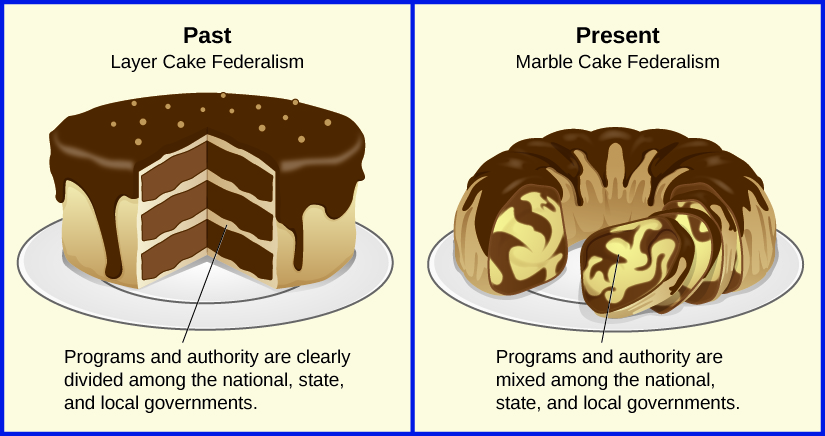| << Chapter < Page | Chapter >> Page > |
During the administrations of Presidents Richard
Nixon (1969–1974) and Ronald
Reagan (1981–1989), attempts were made to reverse the process of nationalization—that is, to restore states’ prominence in policy areas into which the federal government had moved in the past.
New federalism is premised on the idea that the decentralization of policies enhances administrative efficiency, reduces overall public spending, and improves policy outcomes. During Nixon’s administration,
general revenue sharing programs were created that distributed funds to the state and local governments with minimal restrictions on how the money was spent. The election of Ronald Reagan heralded the advent of a “devolution revolution” in U.S. federalism, in which the president pledged to return authority to the states according to the Constitution. In the
Omnibus Budget Reconciliation Act of 1981, congressional leaders together with President Reagan consolidated numerous federal grant programs related to social welfare and reformulated them in order to give state and local administrators greater discretion in using federal funds.
However, Reagan’s track record in promoting new federalism was inconsistent. This was partly due to the fact that the president’s devolution agenda met some opposition from Democrats in Congress, moderate Republicans, and interest groups, preventing him from making further advances on that front. For example, his efforts to completely devolve Aid to Families With Dependent Children (a New Deal-era program) and food stamps (a Great Society-era program) to the states were rejected by members of Congress, who feared states would underfund both programs, and by members of the National Governors’ Association, who believed the proposal would be too costly for states. Reagan terminated general revenue sharing in 1986.
Several Supreme Court rulings also promoted new federalism by hemming in the scope of the national government’s power, especially under the commerce clause. For example, in
United States v. Lopez , the court struck down the
Gun-Free School Zones Act of 1990, which banned gun possession in school zones.
However, many would say that the years since the 9/11 attacks have swung the pendulum back in the direction of central federal power. The creation of the Department of Homeland Security federalized disaster response power in Washington, and the Transportation Security Administration was created to federalize airport security. Broad new federal policies and mandates have also been carried out in the form of the Faith-Based Initiative and No Child Left Behind (during the George W. Bush administration) and the Affordable Care Act (during Barack Obama’s administration).
Morton
Grodzins coined the cake analogy of federalism in the 1950s while conducting research on the evolution of American federalism. Until then most scholars had thought of federalism as a layer cake, but according to Grodzins the 1930s ushered in “marble-cake federalism” (
[link] ): “The American form of government is often, but erroneously, symbolized by a three-layer cake. A far more accurate image is the rainbow or marble cake, characterized by an inseparable mingling of differently colored ingredients, the colors appearing in vertical and diagonal strands and unexpected whirls. As colors are mixed in the marble cake, so functions are mixed in the American federal system.”

Cooperative federalism has several merits:
New federalism has advantages as well:
Which model of federalism do you think works best for the United States? Why?
The leading international journal devoted to the practical and theoretical study of federalism is called Publius: The Journal of Federalism . Find out where its name comes from.
Federalism in the United States has gone through several phases of evolution during which the relationship between the federal and state governments has varied. In the era of dual federalism, both levels of government stayed within their own jurisdictional spheres. During the era of cooperative federalism, the federal government became active in policy areas previously handled by the states. The 1970s ushered in an era of new federalism and attempts to decentralize policy management.

Notification Switch
Would you like to follow the 'American government' conversation and receive update notifications?